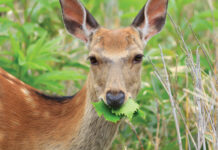Similar to what is happening with ash trees in the U.S. Midwest and East with the infestation of the emerald ash borer, a new pest has invaded the United States from China and Japan and is damaging the crape myrtle tree across much of the South.
The unofficial common name is crape myrtle bark scale according to Dr. Mike Merchant, professor and extension urban entomologist, Texas A & M AgriLife Extension Service. He says that molecular biologists and a USDA/APHIS scale taxonomist are doing a final verification of CMBS.
Merchant says, “Things will become official after we successfully pass peer review and get the research published in a scientific journal.”
CMBS is one of very few scale insects feeding on crape myrtles. Lawn care professionals, arborists and horticulturalists can recognize these insects in their adult and nymphs stage as growing to 1/8-inch-long with oval or oblong, white scale covers. Smaller nymphs may appear grey and “furry.” When smashed, these scales produce pink or purplish “blood.”
According to Merchant, no other scale found on crape myrtle has these characters.
The CMBS lives on the bark of crape myrtle trunks and branches, extracting sap and producing copious amounts of excretion product called “honeydew.” Female scales lay pink eggs, deposited under the scale covers. As the nymphs mature, they secrete a white thread that becomes matted over time into a thick, whitish/grayish protective covering over their bodies.
How to identify CMBS
“Heavy infestations of scale appear white, with scales covering the branches, limbs and tree bark,” says Merchant. “Perhaps the most notable feature of CMBS infestation is the black coating on the lower branches and trunks of infested trees. The black is resulted from growth of a black sooty mold fungus, which feeds on honeydew deposits. The coating reduces the attractiveness of the trees.” CMBS is most active from May to September with peak activity in July and August.
“Its closest cousin is the azalea bark scale, but that species has never been associated with crape myrtle before,” says Merchant.
Like the emerald ash borer before it, Merchant suspects that CMBS was introduced into the United States by accident, perhaps by tourists returning from their travels with infested cuttings.
It was first noticed in central Texas in 2004. Presently, ground zero for the pest is McKinney, Texas, where the infestations have caused widespread damage to crape myrtle. It has since been identified in Little Rock, Ark., Germantown, Tenn., Ardmore, Okla., and in Shreveport and Houma, La.
Noted for its beauty and ease of maintenance, crape myrtle is a popular landscape tree in the South. It bears colorful flower displays through much of the summer, and comes in a variety of stunning colors. Relatively easy to grow, crape myrtle, until recent years, has been relatively pest-free.
Treatment options
Initial treatment trials by Merchant and staff have found some effective treatments for the scale, although the results are preliminary. Merchant says there are many options yet to be tested, but in trials thus far the best treatments include drenching the rootzone with Merit or Bayer Advanced Garden Tree and Shrub Insect Control, and Meridian and Greenlight Tree and Shrub Insect Control with Safari.
Merchant adds, “All of these insecticides produced significant suppression of the scale for 12 weeks after a single application.”
Few natural treatments have been found, although, one of the natural predators to this scale is the twice stabbed ladybug.
“This lady beetle appears to be quite effective once it discovers CMBS colonies, but it is often too late to prevent sooty mold deposits. There are no commercial sources of these beetles that might be used for releases,” says Merchant.
Female scales can also be blasted off the foliage of the crape myrtle with a strong stream of water. It is advisable to cut back on watering and fertilization in spring because rampant, succulent growth is attractive to CMBS. Insecticidal soap might also be an effective option.

Because the trials were conducted for only a short period of time, the effects and timing of additional treatments needs more study. Merchant says some products are known to provide insect control for up to 12 months or more in some species.
Additional research is needed to evaluate whether there is a range in susceptibility across the hundreds of crape myrtle cultivars. Merchant explains, “This scale pest is not limited to infesting only crape myrtle, but it’s unclear as to whether it poses a significant threat to other trees or ornamental plants, or if crape myrtle is the main host.”
Merchant has been working closely with Dr. Mengmeng Gu, extension horticulture specialist, Texas A&M AgriLife, who witnessed the scale in a recent trip to Beijing, China, and who says the evidence suggests that given the presumed scale’s range in Asia, it’s conceivable the scale could spread wherever crape myrtle is grown including the southern Atlantic coast.
According to Merchant, and Texas A&M staff, additional recommendation include:
- For heavily infested plants wash the trunk and reachable limbs with a soft brush and mild solution of dishwashing soap. This will remove many of the female scales and egg masses and make insecticide control more effective. Also, washing will remove much of the black mold that builds up on the bark on infested trees.
- Horticultural oil has not yet been shown to be effective against this insect, however a winter application of dormant oil to the bark and crotches of the plants where scales shelter may be beneficial. Winter is a good time to treat for scales because a higher application rate can be used without damaging the plant. Thorough coverage of the tree is especially important when treating with oil.
Merchant asks that anyone suspecting that they’ve encountered this scale in areas outside those listed in this article contact him.
“I would be interested in knowing about it. We hope to eventually have a website where sightings can be more easily reported.” Direct any photos to your county extension office and/or to his email m-merchant@tamu.edu.











![[VIDEO] Dickies®: Discover Workwear That’s Anything But Uniform](https://turfmagazine.com/wp-content/uploads/2023/06/1647663814-4b1a2a7742790a9b1e97a3b963477850192e1d6a9dfba9b07214a77bae25d6e3-d-218x150.jpg)

































![[VIDEO] Dickies®: Discover Workwear That’s Anything But Uniform](https://turfmagazine.com/wp-content/uploads/2023/06/1647663814-4b1a2a7742790a9b1e97a3b963477850192e1d6a9dfba9b07214a77bae25d6e3-d-324x160.jpg)